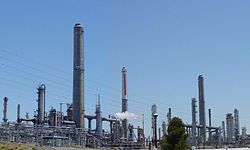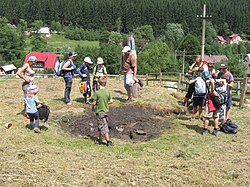Hydrocarbon
A hydrocarbon is a type of chemical compound. It is made of only hydrogen and carbon atoms. They can be found in crude oil and are separated by fractional distillation (which means they are separated into different groups). The hydrogen and carbon are bonded with non-polar covalent bonds. Because of its lack of polar covalent bonds, hydrocarbons cannot create hydrogen bonds with water and are hydrophobic.
Hydrocarbon "families"
Hydrocarbons are grouped into "families" or "homologous series". There are five main families. The hydrocarbons in each family have a general formula and similar chemical properties, and similar trends in physical properties. This system was approved in 1892 by the International Congress of Chemists, meeting in Geneva.
Alkanes
Alkanes are the simplest hydrocarbons. Their general formula is CnH2n+2.
| Alkane Name | Formula |
|---|---|
| Methane | CH4 |
| Ethane | C2H6 |
| Propane | C3H8 |
| Butane | C4H10 |
| Pentane | C5H12 |
| Hexane | C6H14 |
| Heptane | C7H16 |
| Octane | C8H18 |
| Nonane | C9H20 |
| Decane | C10H22 |
Alkenes
Alkenes are similar to alkanes. The main difference between them is that alkenes have a carbon to carbon double bond. The general formula for the alkenes is CnH2n.
| Alkene Name | Formula |
|---|---|
| Ethene | C2H4 |
| Propene | C3H6 |
| Butene | C4H8 |
| Pentene | C5H10 |
| Hexene | C6H12 |
| Heptene | C7H14 |
| Octene | C8H16 |
| Nonene | C9H18 |
| Decene | C10H20 |
Note that there is no "Methene". Methene is not possible as alkenes require a carbon-carbon double bond and methane only has one carbon atom.
Alkynes
Alkynes have a carbon to carbon triple bond. CnH2n-2 is their general formula.
| Alkyne Name | Formula |
|---|---|
| Ethyne (Acetylene) | C2H2 |
| Propyne | C3H4 |
| Butyne | C4H6 |
| Pentyne | C5H8 |
| Hexyne | C6H10 |
| Heptyne | C7H12 |
| Octyne | C8H14 |
| Nonyne | C9H16 |
| Decyne | C10H18 |
"Methyne" does not exist because of methane's one carbon atom.
Cycloalkanes
Cycloalkanes are isomers of alkenes. They have the same general formula (CnH2n), the only difference is that they do not have a carbon to carbon double bond.
| Cycloalkane Name | Formula |
|---|---|
| Cyclopropane | C3H6 |
| Cyclobutane | C4H8 |
| Cyclopentane | C5H10 |
| Cyclohexane | C6H12 |
| Cycloheptane | C7H14 |
| Cycloctane | C8H16 |
| Cyclononane | C9H18 |
| Cyclodecane | C10H20 |
Note that ethene does not have a cycloalkane as it can only form a straight line.
Alkadiene
Alkadienes have two carbon to carbon double bonds. Their general formula is CnH2n-2. They are isomers of alkynes.
In a similar manner, there can also exist alkatriene (three carbon to carbon bonds) and other forms. The versatile nature of Carbon's chemistry allows for a nearly infinite number of configurations and compounds.
Aromatic hydrocarbons
Hydrocarbon Media
Ball-and-stick model of the methane molecule, CH4. Methane is part of a homologous series known as the alkanes, which contain single bonds only.
Oil refineries are one way hydrocarbons are processed for use. Crude oil is processed in several stages to form desired hydrocarbons, used as fuel and in other products.
Mechanisms involved in hydrocarbon phytoremediation
Aromatic hydrocarbons are aromatic organic molecules that form flat ring-shaped bonds. The most simplest of aromatic hydrocarbons are benzene and indole. They can have one ring, heterocyclic, like benzene or 2 rings, bicyclic like napthalene (primary ingredient in mothballs) or many rings, polycyclic like anthracene (red dye colourant). Their general formula is CnH2n-6, where n is a number greater than or equal to 6.




